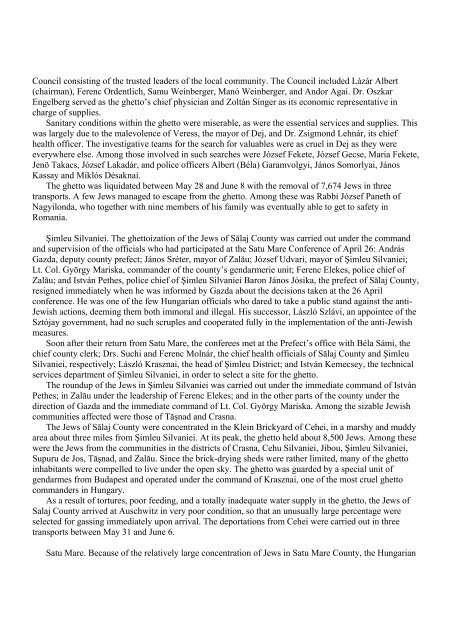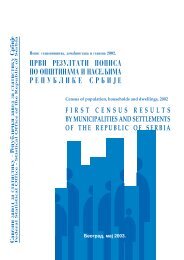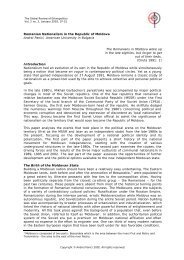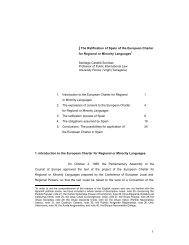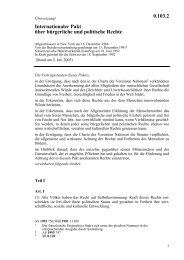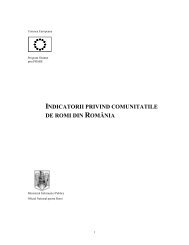Final Report of the International Commission on the - Minority Rights ...
Final Report of the International Commission on the - Minority Rights ...
Final Report of the International Commission on the - Minority Rights ...
Create successful ePaper yourself
Turn your PDF publications into a flip-book with our unique Google optimized e-Paper software.
Council c<strong>on</strong>sisting <str<strong>on</strong>g>of</str<strong>on</strong>g> <str<strong>on</strong>g>the</str<strong>on</strong>g> trusted leaders <str<strong>on</strong>g>of</str<strong>on</strong>g> <str<strong>on</strong>g>the</str<strong>on</strong>g> local community. The Council included Lázár Albert<br />
(chairman), Ferenc Ordentlich, Samu Weinberger, Manó Weinberger, and Andor Agai. Dr. Oszkar<br />
Engelberg served as <str<strong>on</strong>g>the</str<strong>on</strong>g> ghetto’s chief physician and Zoltán Singer as its ec<strong>on</strong>omic representative in<br />
charge <str<strong>on</strong>g>of</str<strong>on</strong>g> supplies.<br />
Sanitary c<strong>on</strong>diti<strong>on</strong>s within <str<strong>on</strong>g>the</str<strong>on</strong>g> ghetto were miserable, as were <str<strong>on</strong>g>the</str<strong>on</strong>g> essential services and supplies. This<br />
was largely due to <str<strong>on</strong>g>the</str<strong>on</strong>g> malevolence <str<strong>on</strong>g>of</str<strong>on</strong>g> Veress, <str<strong>on</strong>g>the</str<strong>on</strong>g> mayor <str<strong>on</strong>g>of</str<strong>on</strong>g> Dej, and Dr. Zsigm<strong>on</strong>d Lehnár, its chief<br />
health <str<strong>on</strong>g>of</str<strong>on</strong>g>ficer. The investigative teams for <str<strong>on</strong>g>the</str<strong>on</strong>g> search for valuables were as cruel in Dej as <str<strong>on</strong>g>the</str<strong>on</strong>g>y were<br />
everywhere else. Am<strong>on</strong>g those involved in such searches were József Fekete, József Gecse, Maria Fekete,<br />
Jenö Takacs, József Lakadár, and police <str<strong>on</strong>g>of</str<strong>on</strong>g>ficers Albert (Béla) Garamvolgyi, János Somorlyai, János<br />
Kassay and Miklós Désaknai.<br />
The ghetto was liquidated between May 28 and June 8 with <str<strong>on</strong>g>the</str<strong>on</strong>g> removal <str<strong>on</strong>g>of</str<strong>on</strong>g> 7,674 Jews in three<br />
transports. A few Jews managed to escape from <str<strong>on</strong>g>the</str<strong>on</strong>g> ghetto. Am<strong>on</strong>g <str<strong>on</strong>g>the</str<strong>on</strong>g>se was Rabbi József Paneth <str<strong>on</strong>g>of</str<strong>on</strong>g><br />
Nagyil<strong>on</strong>da, who toge<str<strong>on</strong>g>the</str<strong>on</strong>g>r with nine members <str<strong>on</strong>g>of</str<strong>on</strong>g> his family was eventually able to get to safety in<br />
Romania.<br />
Şimleu Silvaniei. The ghettoizati<strong>on</strong> <str<strong>on</strong>g>of</str<strong>on</strong>g> <str<strong>on</strong>g>the</str<strong>on</strong>g> Jews <str<strong>on</strong>g>of</str<strong>on</strong>g> Sălaj County was carried out under <str<strong>on</strong>g>the</str<strong>on</strong>g> command<br />
and supervisi<strong>on</strong> <str<strong>on</strong>g>of</str<strong>on</strong>g> <str<strong>on</strong>g>the</str<strong>on</strong>g> <str<strong>on</strong>g>of</str<strong>on</strong>g>ficials who had participated at <str<strong>on</strong>g>the</str<strong>on</strong>g> Satu Mare C<strong>on</strong>ference <str<strong>on</strong>g>of</str<strong>on</strong>g> April 26: András<br />
Gazda, deputy county prefect; János Sréter, mayor <str<strong>on</strong>g>of</str<strong>on</strong>g> Zalău; József Udvari, mayor <str<strong>on</strong>g>of</str<strong>on</strong>g> Şimleu Silvaniei;<br />
Lt. Col. György Mariska, commander <str<strong>on</strong>g>of</str<strong>on</strong>g> <str<strong>on</strong>g>the</str<strong>on</strong>g> county’s gendarmerie unit; Ferenc Elekes, police chief <str<strong>on</strong>g>of</str<strong>on</strong>g><br />
Zalău; and István Pe<str<strong>on</strong>g>the</str<strong>on</strong>g>s, police chief <str<strong>on</strong>g>of</str<strong>on</strong>g> Şimleu Silvaniei Bar<strong>on</strong> János Jósika, <str<strong>on</strong>g>the</str<strong>on</strong>g> prefect <str<strong>on</strong>g>of</str<strong>on</strong>g> Sălaj County,<br />
resigned immediately when he was informed by Gazda about <str<strong>on</strong>g>the</str<strong>on</strong>g> decisi<strong>on</strong>s taken at <str<strong>on</strong>g>the</str<strong>on</strong>g> 26 April<br />
c<strong>on</strong>ference. He was <strong>on</strong>e <str<strong>on</strong>g>of</str<strong>on</strong>g> <str<strong>on</strong>g>the</str<strong>on</strong>g> few Hungarian <str<strong>on</strong>g>of</str<strong>on</strong>g>ficials who dared to take a public stand against <str<strong>on</strong>g>the</str<strong>on</strong>g> anti-<br />
Jewish acti<strong>on</strong>s, deeming <str<strong>on</strong>g>the</str<strong>on</strong>g>m both immoral and illegal. His successor, László Szlávi, an appointee <str<strong>on</strong>g>of</str<strong>on</strong>g> <str<strong>on</strong>g>the</str<strong>on</strong>g><br />
Sztójay government, had no such scruples and cooperated fully in <str<strong>on</strong>g>the</str<strong>on</strong>g> implementati<strong>on</strong> <str<strong>on</strong>g>of</str<strong>on</strong>g> <str<strong>on</strong>g>the</str<strong>on</strong>g> anti-Jewish<br />
measures.<br />
So<strong>on</strong> after <str<strong>on</strong>g>the</str<strong>on</strong>g>ir return from Satu Mare, <str<strong>on</strong>g>the</str<strong>on</strong>g> c<strong>on</strong>ferees met at <str<strong>on</strong>g>the</str<strong>on</strong>g> Prefect’s <str<strong>on</strong>g>of</str<strong>on</strong>g>fice with Béla Sámi, <str<strong>on</strong>g>the</str<strong>on</strong>g><br />
chief county clerk; Drs. Suchi and Ferenc Molnár, <str<strong>on</strong>g>the</str<strong>on</strong>g> chief health <str<strong>on</strong>g>of</str<strong>on</strong>g>ficials <str<strong>on</strong>g>of</str<strong>on</strong>g> Sălaj County and Şimleu<br />
Silvaniei, respectively; László Krasznai, <str<strong>on</strong>g>the</str<strong>on</strong>g> head <str<strong>on</strong>g>of</str<strong>on</strong>g> Şimleu District; and István Kemecsey, <str<strong>on</strong>g>the</str<strong>on</strong>g> technical<br />
services department <str<strong>on</strong>g>of</str<strong>on</strong>g> Şimleu Silvaniei, in order to select a site for <str<strong>on</strong>g>the</str<strong>on</strong>g> ghetto.<br />
The roundup <str<strong>on</strong>g>of</str<strong>on</strong>g> <str<strong>on</strong>g>the</str<strong>on</strong>g> Jews in Şimleu Silvaniei was carried out under <str<strong>on</strong>g>the</str<strong>on</strong>g> immediate command <str<strong>on</strong>g>of</str<strong>on</strong>g> István<br />
Pe<str<strong>on</strong>g>the</str<strong>on</strong>g>s; in Zalău under <str<strong>on</strong>g>the</str<strong>on</strong>g> leadership <str<strong>on</strong>g>of</str<strong>on</strong>g> Ferenc Elekes; and in <str<strong>on</strong>g>the</str<strong>on</strong>g> o<str<strong>on</strong>g>the</str<strong>on</strong>g>r parts <str<strong>on</strong>g>of</str<strong>on</strong>g> <str<strong>on</strong>g>the</str<strong>on</strong>g> county under <str<strong>on</strong>g>the</str<strong>on</strong>g><br />
directi<strong>on</strong> <str<strong>on</strong>g>of</str<strong>on</strong>g> Gazda and <str<strong>on</strong>g>the</str<strong>on</strong>g> immediate command <str<strong>on</strong>g>of</str<strong>on</strong>g> Lt. Col. György Mariska. Am<strong>on</strong>g <str<strong>on</strong>g>the</str<strong>on</strong>g> sizable Jewish<br />
communities affected were those <str<strong>on</strong>g>of</str<strong>on</strong>g> Tăşnad and Crasna.<br />
The Jews <str<strong>on</strong>g>of</str<strong>on</strong>g> Sălaj County were c<strong>on</strong>centrated in <str<strong>on</strong>g>the</str<strong>on</strong>g> Klein Brickyard <str<strong>on</strong>g>of</str<strong>on</strong>g> Cehei, in a marshy and muddy<br />
area about three miles from Şimleu Silvaniei. At its peak, <str<strong>on</strong>g>the</str<strong>on</strong>g> ghetto held about 8,500 Jews. Am<strong>on</strong>g <str<strong>on</strong>g>the</str<strong>on</strong>g>se<br />
were <str<strong>on</strong>g>the</str<strong>on</strong>g> Jews from <str<strong>on</strong>g>the</str<strong>on</strong>g> communities in <str<strong>on</strong>g>the</str<strong>on</strong>g> districts <str<strong>on</strong>g>of</str<strong>on</strong>g> Crasna, Cehu Silvaniei, Jibou, Şimleu Silvaniei,<br />
Supuru de Jos, Tăşnad, and Zalău. Since <str<strong>on</strong>g>the</str<strong>on</strong>g> brick-drying sheds were ra<str<strong>on</strong>g>the</str<strong>on</strong>g>r limited, many <str<strong>on</strong>g>of</str<strong>on</strong>g> <str<strong>on</strong>g>the</str<strong>on</strong>g> ghetto<br />
inhabitants were compelled to live under <str<strong>on</strong>g>the</str<strong>on</strong>g> open sky. The ghetto was guarded by a special unit <str<strong>on</strong>g>of</str<strong>on</strong>g><br />
gendarmes from Budapest and operated under <str<strong>on</strong>g>the</str<strong>on</strong>g> command <str<strong>on</strong>g>of</str<strong>on</strong>g> Krasznai, <strong>on</strong>e <str<strong>on</strong>g>of</str<strong>on</strong>g> <str<strong>on</strong>g>the</str<strong>on</strong>g> most cruel ghetto<br />
commanders in Hungary.<br />
As a result <str<strong>on</strong>g>of</str<strong>on</strong>g> tortures, poor feeding, and a totally inadequate water supply in <str<strong>on</strong>g>the</str<strong>on</strong>g> ghetto, <str<strong>on</strong>g>the</str<strong>on</strong>g> Jews <str<strong>on</strong>g>of</str<strong>on</strong>g><br />
Salaj County arrived at Auschwitz in very poor c<strong>on</strong>diti<strong>on</strong>, so that an unusually large percentage were<br />
selected for gassing immediately up<strong>on</strong> arrival. The deportati<strong>on</strong>s from Cehei were carried out in three<br />
transports between May 31 and June 6.<br />
Satu Mare. Because <str<strong>on</strong>g>of</str<strong>on</strong>g> <str<strong>on</strong>g>the</str<strong>on</strong>g> relatively large c<strong>on</strong>centrati<strong>on</strong> <str<strong>on</strong>g>of</str<strong>on</strong>g> Jews in Satu Mare County, <str<strong>on</strong>g>the</str<strong>on</strong>g> Hungarian


